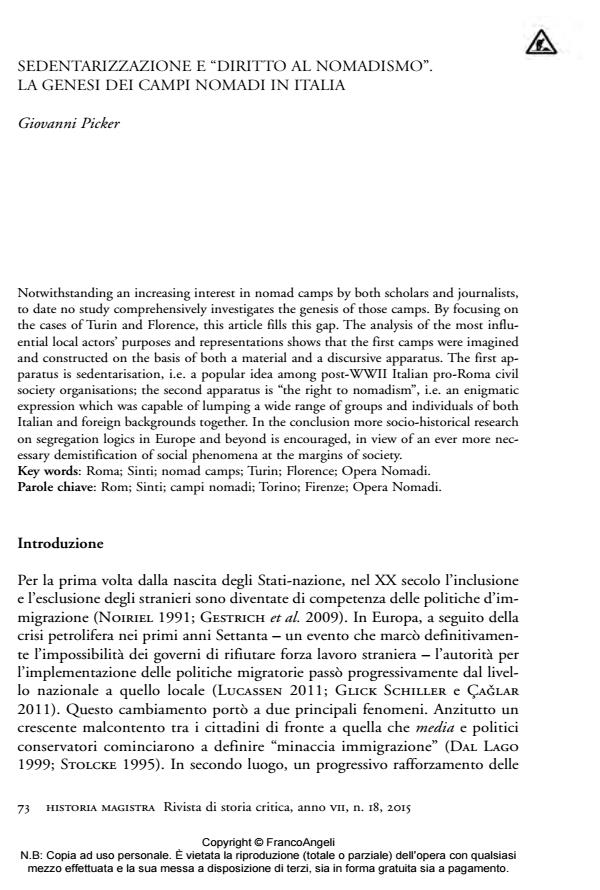Sedentarizzazione e "diritto al nomadismo". La genesi dei campi nomadi in Italia
Titolo Rivista HISTORIA MAGISTRA
Autori/Curatori Giovanni Picker
Anno di pubblicazione 2015 Fascicolo 2015/18 Lingua Italiano
Numero pagine 12 P. 73-84 Dimensione file 101 KB
DOI 10.3280/HM2015-018006
Il DOI è il codice a barre della proprietà intellettuale: per saperne di più
clicca qui
Qui sotto puoi vedere in anteprima la prima pagina di questo articolo.
Se questo articolo ti interessa, lo puoi acquistare (e scaricare in formato pdf) seguendo le facili indicazioni per acquistare il download credit. Acquista Download Credits per scaricare questo Articolo in formato PDF

FrancoAngeli è membro della Publishers International Linking Association, Inc (PILA)associazione indipendente e non profit per facilitare (attraverso i servizi tecnologici implementati da CrossRef.org) l’accesso degli studiosi ai contenuti digitali nelle pubblicazioni professionali e scientifiche
Notwithstanding an increasing interest in nomad camps by both scholars and journalists, to date no study comprehensively investigates the genesis of those camps. By focusing on the cases of Turin and Florence, this article fills this gap. The analysis of the most influential local actors’ purposes and representations shows that the first camps were imagined and constructed on the basis of both a material and a discursive apparatus. The first apparatus is sedentarisation, i.e. a popular idea among post-WWII Italian pro-Roma civil society organisations; the second apparatus is "the right to nomadism", i.e. an enigmatic expression which was capable of lumping a wide range of groups and individuals of both Italian and foreign backgrounds together. In the conclusion more socio-historical research on segregation logics in Europe and beyond is encouraged, in view of an ever more necessary demistification of social phenomena at the margins of society.;
Keywords:Rom; Sinti; campi nomadi; Torino; Firenze; Opera Nomadi
- Bravi, L. (2009), Tra inclusione ed esclusione. Una storia sociale dell’educazione di rom e sinti in Italia, Unicopli, Milano.
- Bravi, L. e Sigona, N. (2007), Educazione e rieducazione nei campi nomadi: una storia, in «Studi Emigrazione», 18, pp. 857-74.
- Brunello, P. (1996), L’urbanistica del disprezzo. Campi nomadi e società italiana, Manifestolibri, Roma.
- Colacicchi, P. (1996), Rom a Firenze, in Brunello, P. (a cura di), L’urbanistica del disprezzo, Manifestolibri, Roma.
- Dal Lago, A. (1999), Non-persone. L’esclusione dei migranti in una società globale, Feltrinelli, Milano.
- ERRC (European Roma Rights Centre) (2000), Campland. The Racial Segregation of Roma in Italy. European Roma Rights Centre, Budapest.
- Foucault, M. (1980), Power/Knowledge. Selected Interviews and Other Writings, 1972-1977, a cura di Colin Gordon, Pantheon Books, New York.
- Gaddi, V. (2002), I rom a Firenze: analisi di un processo di integrazione, tesi di laurea, Università di Firenze.
- Gangemi, F. (1970), “Il diritto al nomadismo”, in «Lacio Drom», 6 (3), pp. 2-24.
- Gestrich A., Lutz, R., and Uerlings, H. (a cura di) (2009), Strangers and Poor People. Changing Patterns of Inclusion and Exclusion in Europe and the Mediterranean World from Classic Antiquity to the Present Day, Peter Lang, Frankfurt am Main.
- Glick Schiller, N. e Çagˇlar, A. (a cura di) (2011), Locating Migration: Rescaling Cities and Migrants, Ithaca, Cornell University Press, NY.
- Lindner, J. (2013), Orientalisation of Roma communities. Forms of Representation and Categorisation of Roma Communities in International Governmental Institutions, in «Zeitgeschichte» 5(13), pp. 259-75. Lucassen, L. (2011), Cities, States and Migration Control in Western Europe. Comparing then and now, in Muck, B. e Winter, A. (a cura di,) Gated communities? Regulating Migration in Early Modern Cities, Ashgate, Aldershot.
- Noiriel, G. (1991), La tyrannie du national. Le droit d’asile en Europe (1793-1993), Calmann-Lévy, Paris.
- Palidda, S. (2000), Polizia postmoderna. Etnografia del nuovo controllo sociale, Feltrinelli, Milano.
- Piasere, L. (2006), Che cos’è un campo nomadi?, in «Achab. Rivista di antropologia», 8, pp. 8-16.
- Picker, G. (2011), Welcome ‘in’. Left-wing Tuscany and Romani migrants (1987-2007), in «Journal of Modern Italian Studies», 16 (5), pp. 607-20.
- Id. (2010), Nomads’ Land? Political Cultures and Nationalist Stances vis-à-vis Roma in Italy, in M. Stewart e M. Rövid (a cura di) Multidisciplinary Approaches to Romany Studies, Central European University Press, Budapest, pp. 211-27.
- Picker, G. e Roccheggiani, G. (2014), Abnormalising minorities. The state and expert knowledge addressing the Roma in Italy, in «Identities: Global Studies in Culture and Power», 21 (2), pp.185-201.
- Roccheggiani, G. (2014), Come spighe tra granaio e campo. Lineamenti filosoficopolitici della ‘questione rom’ in Italia, Aras Edizioni, Fano.
- Saletti Salza, C. (2003), Bambini del campo nomadi. Roma bosniaci a Torino, CISU, Roma.
- Shore, C., Wright, S. e Però, D. (2011), Policy Worlds. Anthropology and the Analysis of Contemporary Power, Berghahn Books, New York and Oxford.
- Sigona, N. (2005), Locating the “Gypsy problem”. The Roma in Italy: Stereotyping, Labelling and the “Nomad Camps”, in «Journal of Ethnic and Migration Studies», 31, 4, pp. 741-56.
- Simhandl, K. (2009), Beyond Boundaries: Comparing the Construction of the Poltical Categories ‘Gypsies’ and ‘Roma’ before and after EU Enlargment, in Sigona, N. e Trehan, N. (a cura di) Romani Politics in Contemporary Europe. Poverty, Ethnopolitics and the Neoliberal Order, Palgrave, Basingstoke.
- Stolcke, V. (1995), Talking Culture: New Boundaries, New Rhetorics of Exclusion in Europe, in «Current Anthropology», 36, pp. 1-24.
- Tauber, E. (2010), Adriano Colocci Vespucci – bekanntester italienischer “Zigeunerforscher” des ausgehenden 19. Jahrhunderts und aktiver Faschist ab 1915, in «Geschichte und Region/Storia e regione» 19, 1, pp. 173-82.
- Tremlett, A. (2009), Bringing hybridity to heterogeneity in Romani Studies, in «Romani Studies», 5, 19, pp. 147-68.
- Willems, W. (1997), In Search of the True Gypsy: From Enlightenment to Final Solution, Frank Cass, London.
Giovanni Picker, Sedentarizzazione e "diritto al nomadismo". La genesi dei campi nomadi in Italia in "HISTORIA MAGISTRA" 18/2015, pp 73-84, DOI: 10.3280/HM2015-018006